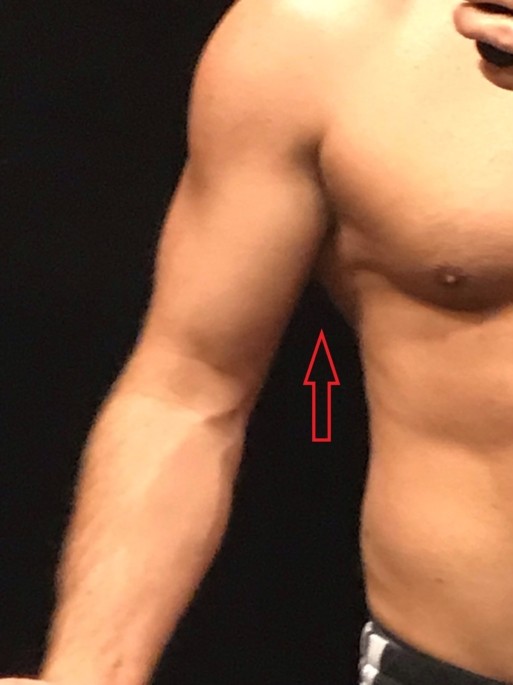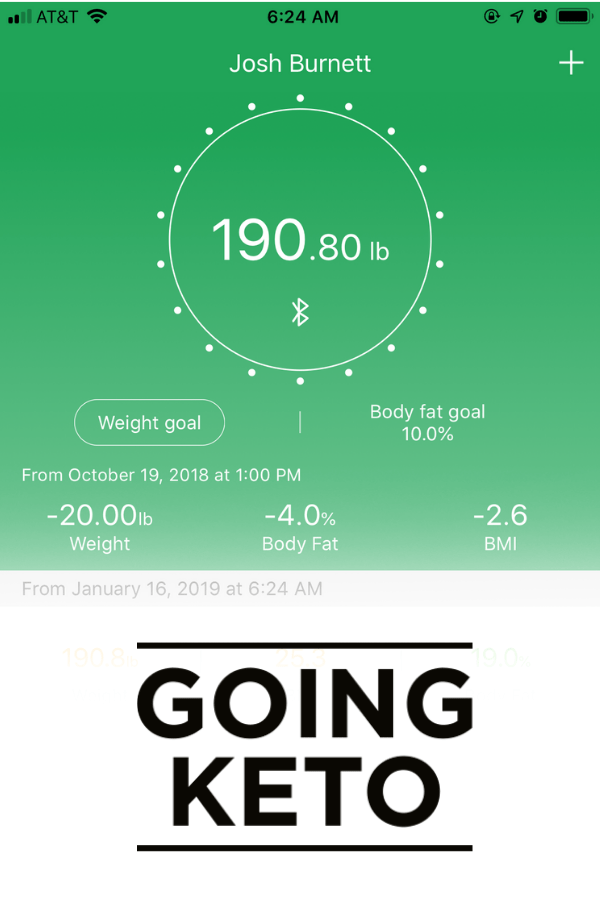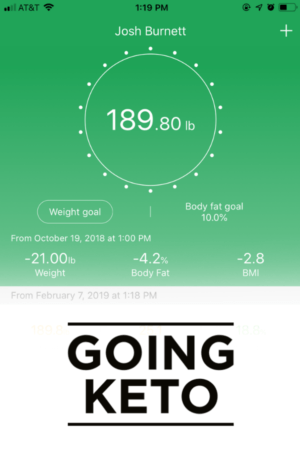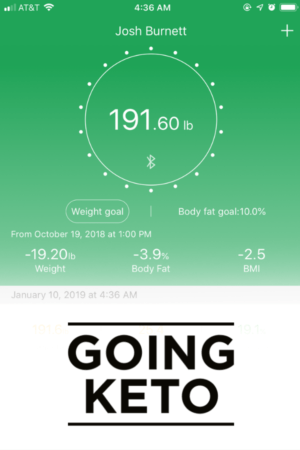The Weight Loss
This week’s weight loss slowed down drastically: I lost a mere 0.8 pounds and 0.1 percent body fat. One of the things I’ve had to keep in mind is that it’s relatively easy to burn fat (I’ve been averaging three pounds per week for most of GoingKeto), but it’s more difficult to build muscle—the max rate of growth is about half a pound per week.
I’ve been paying more attention to my body’s appearance and am seeing regular gains. Here’s a recent progress pic; sorry for the grainy quality, but I zoomed in to emphasize a few things. First, you can see that the muscle tone is improving: my biceps, triceps, and deltoids are taking on a more defined shape. Second, my veins are obviously popping, which is a sign of decreased body fat percentage and improved vascular health. My waist is trimmer, my pecs are becoming more muscular, and my lats are visible from the front (see the red arrow).

What Went Well
Your body has a natural point of homeostasis, where it reaches a comfortable body weight, fat percentage, and can consistently exist in homeostasis. I’m nearing that point. While I’m not satisfied with just staying there and will continue to work to improve, it’s important to recognize how far I’ve come. I felt like a fat slob when I started keto, and now I consistently feel like a champ. For example, I’ve lost eight inches off my waistline, which feels incredible.
What Was Hard
When you’re used to seeing the numbers on the scale move rapidly, it can be discouraging to hit a plateau. When you do observe the amount of change decrease, however, you need to check a couple of things.
First, ensure that your macros are on point. The macros I calculated 22 pounds ago are a far cry from what I need now, so consistently update those and adjust your diet to compensate. If your macros are on track, however…
Look at your hydration. Staying well-hydrated allows your body to efficiently process fat, get rid of waste, and keeps the hormones which are critical to weight loss functioning correctly. The general guideline is to drink half your body weight in ounces of water daily (e.g., if you weight 200 pounds, you should be drinking 100 ounces of water).
Remember, though, that every ounce of tea, coffee, or soda you drink actually dehydrates you, so you need to compensate for that by increasing your water intake. Every ounce of those drinks needs to be matched with one to two ounces of water. Let’s say you need to drink 100 ounces of water, but you drink 20 ounces of coffee per day; that means you’ll need an additional 40 ounces of water to stay hydrated. If the thought of consuming 5 quarts of liquid per day is overwhelming, the best way to handle it is to decrease your non-water fluid intake.
If you’re participating in intermittent fasting, review your eating windows and make sure you’re staying on track there. If you’ve been doing keto for a month or longer, it’s likely that you’re pretty fat-adapted, meaning you can even tighten up your eating window by an hour or two, which can lead to increased fat-burning benefits.
If all of those things are on track, be patient. In my case, 22 pounds is a lot to lose in such a short period of time, and the body needs to adjust to what is normal now. Your basic metabolic rate (BMR) will change, but it takes time to adjust to your new body composition.
The Next Week
I’ve mentioned it previously, but keto has me hooked. While I’ve got a month left in the official GoingKeto journey, I don’t plan on stopping. For the next week, I’m going to be focused on staying strict on my macros while continuing my lifting routine.
NUTRITIONAL DISCLAIMER
The content on this website should not be taken as medical advice and you should ALWAYS consult with your doctor before starting any diet or exercise program. We provide nutritional data for our recipes as a courtesy to our readers. We use Total Keto Diet app software to calculate the nutrition and we remove fiber and sugar alcohols, like erythritol, from the total carbohydrate count to get to the net carb count, as they do not affect your blood glucose levels. You should independently calculate nutritional information on your own and not rely on our data. The website or content herein is not intended to cure, prevent, diagnose or treat any disease. This website shall not be liable for adverse reactions or any other outcome resulting from the use of recipes or recommendations on the Website or actions you take as a result. Any action you take is strictly at your own risk.
- The Brain’s Role in Weight Loss - March 11, 2019
- Making Fat Loss EPOC - March 8, 2019
- Overcoming Plateaus - March 6, 2019




